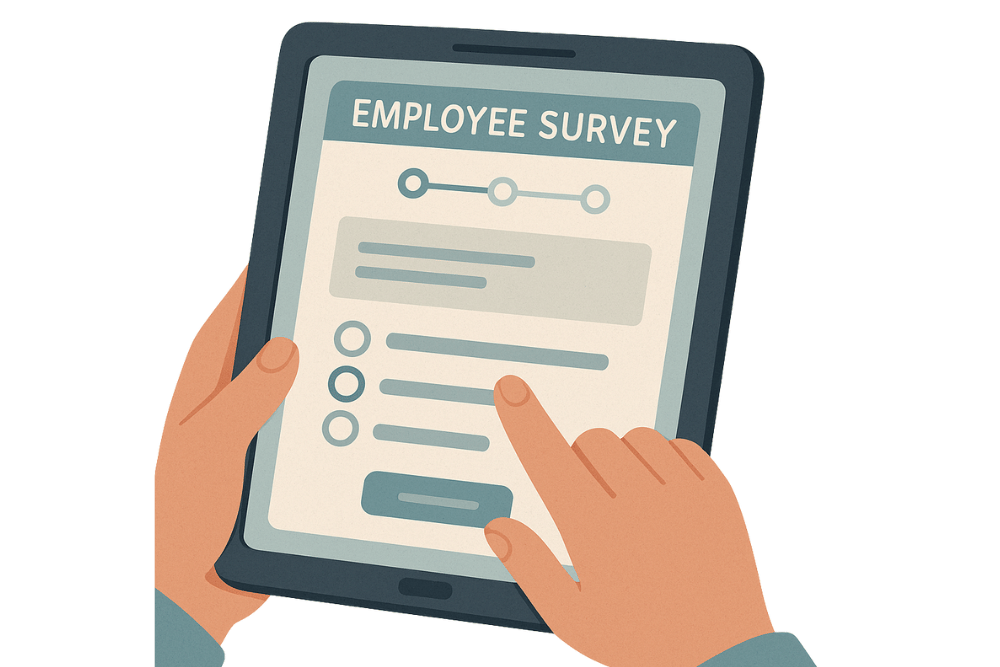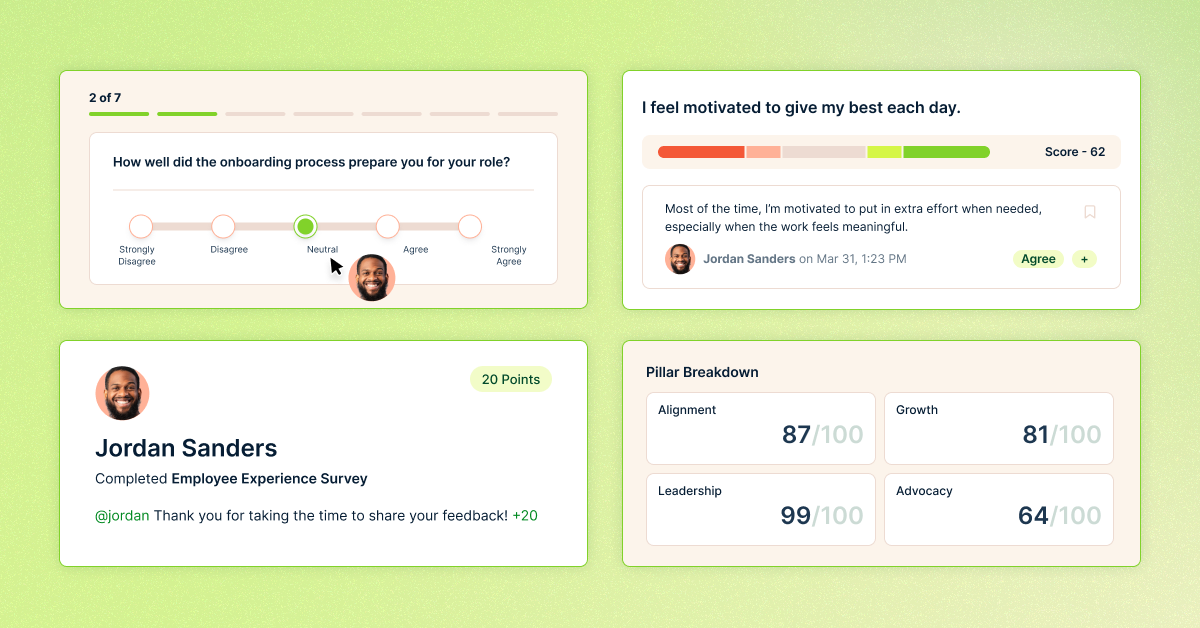Unlocking Employee Engagement: Nectar's Expert Guide 2025

Here's the TL;DR
Employee survey software is a digital platform that captures, analyzes, and reports workforce feedback in real time, enabling organizations to build continuous listening cultures that drive engagement, retention, and productivity. Unlike annual surveys, modern tools use frequent pulse, engagement, and lifecycle surveys to deliver timely insights into employee sentiment and potential turnover risks. Research shows highly engaged companies outperform peers by up to 147% in earnings per share, making survey software a strategic investment.
Key features that maximize participation include mobile-friendly design, anonymity controls, AI-driven analytics, and real-time dashboards. Mobile optimization increases completion rates by up to 30%, while anonymity builds trust and candor. AI capabilities—such as sentiment scoring, predictive turnover alerts, and automated action plans—transform raw data into actionable strategies.
A critical differentiator is linking survey insights to recognition programs. Platforms like Nectar integrate survey feedback with real-time recognition, closing the loop between data and action. For example, pulse survey results highlighting recognition gaps can trigger peer shout-outs or reward campaigns, directly improving morale and retention.
By connecting continuous feedback with meaningful recognition, organizations can reduce turnover, boost productivity, and strengthen culture—turning survey results into measurable business outcomes in 2025 and beyond.
Employee survey software is a digital platform that captures, analyzes, and reports workforce feedback in real-time, transforming how organizations measure and improve engagement. With organizations with high engagement outperforming peers by up to 147% in earnings per share, the stakes for getting feedback right have never been higher. This comprehensive guide reveals how to leverage survey technology and recognition platforms like Nectar to create continuous listening cultures that drive measurable business results in 2025.
What Is Employee Survey Software and Why It Matters
Employee survey software is a digital platform that captures, analyzes, and reports workforce feedback in real-time through automated questionnaires, sentiment analysis, and dashboard reporting. Unlike traditional paper-based surveys, modern platforms enable "continuous listening" – the practice of collecting frequent, short-form surveys (pulse checks) instead of annual questionnaires. This approach provides organizations with timely insights into employee sentiment, engagement levels, and potential retention risks.
The business impact of effective employee engagement measurement cannot be overstated. Organizations with high engagement outperform peers by up to 147% in earnings per share, making survey software a critical investment rather than an optional HR tool.
How Surveys Support Employee Engagement
Regular feedback loops through survey software keep employees feeling heard and valued, which directly correlates with higher morale and reduced turnover intentions. When employees see their input translated into meaningful organizational changes, they develop stronger emotional connections to their workplace. Disengaged employees are 2.5× more likely to leave their organizations, making continuous listening a powerful retention strategy.
A compelling example comes from a regional hospital system that reduced first-year nursing attrition from 30% to 18% after implementing bi-weekly pulse surveys. By identifying stress points early and responding with targeted Nectar recognition programs that celebrated daily wins and reinforced core values, they saved an estimated $2.3 million in recruitment and training costs.
Core Survey Types: Engagement, Pulse, Lifecycle
Three primary survey categories form the foundation of comprehensive employee feedback systems:
- Engagement Survey – comprehensive annual assessment of overall employee sentiment across multiple dimensions
- Pulse Survey – short, frequent check-ins (often 5-10 questions) to capture moment-to-moment sentiment trends
- Lifecycle Survey – targeted surveys at key employee milestones including onboarding, promotion, and exit interviews
Common Pitfalls: Fatigue and Bias
Survey fatigue occurs when declining response rates follow surveys exceeding 15 minutes in length, while response bias manifests through social desirability responses and self-selection among participants. Research indicates that lengthy surveys create participation barriers and skewed data sets that undermine decision-making quality.
To mitigate these challenges, keep surveys under 5 minutes and rotate question pools across survey cycles to maintain engagement while reducing bias. Anonymous submission options and clear privacy statements further encourage honest feedback.
Key Features That Boost Participation and Feedback Quality
Selecting survey software with participation-driving features directly impacts response rates and data quality, creating the foundation for meaningful engagement insights.
What Key Features Should I Look for in Employee Survey Software to Maximize Participation and Feedback Quality?
Critical features that maximize survey effectiveness include:
- Mobile-Friendly Design: Responsive UI across smartphones, tablets, and desktops ensures accessibility for all workforce segments
- Anonymity Controls: Optional anonymous submission with transparent privacy policies encourages honest feedback
- AI-Driven Analytics: Sentiment analysis, predictive turnover modeling, and automated action recommendations transform raw data into insights
- Real-Time Dashboards: Live visualizations accessible to managers and employees create transparency and accountability
- Multi-Language Support: Localized content enables global participation across diverse teams
Market trends show 80.2% of survey software revenue comes from cloud-native, mobile-first platforms, reflecting the critical importance of modern technical architecture.
Mobile-Friendly Design and Multi-Device Access
Responsive layout design and native mobile applications for iOS and Android devices increase completion rates by up to 30% compared to desktop-only solutions. Mobile optimization removes participation barriers for frontline workers, remote employees, and field-based teams.
Best-practice UI elements for mobile survey design include:
- Large touch targets for easy navigation
- Auto-save functionality to prevent data loss
- Push notification reminders with customizable timing
- Offline completion capabilities with sync-when-connected features
Anonymity, Privacy, and Data Security
GDPR (General Data Protection Regulation) and CCPA (California Consumer Privacy Act) establish legal frameworks requiring explicit consent for personal data collection and processing. Anonymous feedback options encourage honesty by removing fear of retaliation, though bias concerns around self-selection must be addressed through representative sampling strategies.
Nectar's platform maintains compliance through end-to-end encryption, role-based access controls, and transparent data handling policies that build employee trust in the feedback process.
AI-Driven Analytics and Actionable Dashboards
Three essential AI capabilities transform survey data into actionable intelligence:
- Sentiment Scoring – converts open-text comments into positive/negative/neutral scores with confidence ratings
- Predictive Turnover Alerts – flags employees with rising disengagement risk based on response patterns and sentiment trends
- Automated Action Plans – suggests specific recognition interventions, training programs, or policy adjustments based on identified gaps
AI integration trends show organizations achieving 40% faster time-to-insight when leveraging machine learning for survey analysis. Dashboard visualizations should include "Top 3 Engagement Gaps" widgets that prioritize leadership attention on high-impact opportunities.
Turning Survey Results Into Actionable Engagement Strategies
Data is only as valuable as the actions it drives, making the translation from survey insights to behavioral interventions the critical success factor for engagement programs.
How Can Employee Survey Software Help in Identifying and Addressing Workforce Engagement Challenges?
Effective survey software follows a systematic flow: collect feedback → analyze patterns → surface engagement gaps → design targeted interventions → measure impact through follow-up surveys. Predictive analytics play a crucial role by surfacing hidden issues before they escalate into retention crises or productivity declines.
This proactive approach enables organizations to address engagement challenges when they're still manageable, rather than reactive crisis management after problems have already impacted business results.
Identifying Engagement Gaps With Predictive Analytics
Machine-learning models compare current sentiment scores to historical baselines, flagging departments or teams experiencing statistically significant declines in engagement metrics. These algorithms identify patterns invisible to manual analysis, such as seasonal trends, manager-specific issues, or policy impacts.
For example, a 12% decline in "Feeling Valued" scores within a specific department triggers automated alerts to HR and management teams, enabling immediate intervention through targeted Nectar recognition campaigns or one-on-one coaching sessions.
Prioritizing Actions and Creating Recognition Loops
Survey themes map directly to recognition strategies through platforms like Nectar:
- Recognition gaps → peer-to-peer shout-outs tied to core values
- Work-life balance concerns → flexible schedule acknowledgments and wellness perks
- Career development needs → skill-building badges and learning stipends
The feedback loop closes when post-recognition pulse surveys measure immediate impact, creating data-driven recognition cultures that reinforce positive behaviors and address engagement gaps systematically.
Measuring Impact on Turnover, Productivity, and Morale
Three key ROI metrics demonstrate survey program effectiveness:
- Turnover Reduction – track percentage change in voluntary exits following targeted interventions
- Productivity Gains – measure proxy indicators like overtime hours saved, project completion rates, or customer satisfaction scores
- Morale Index – aggregate sentiment score trends over 6-month periods to identify sustained improvements
Research confirms that engaged organizations see measurable improvements across all three metrics, with some achieving 25% reductions in turnover and 18% increases in productivity within 12 months.
Selecting and Rolling Out a Survey Platform That Fits Your Needs
Matching platform capabilities to organizational size, culture, and technical infrastructure ensures successful adoption and long-term value creation from survey investments.
Evaluation Criteria: Integration, Scalability, Support
Platform selection checklist:
Integration Requirements:
- Slack, Microsoft Teams, and communication platform APIs
- HRIS systems (Workday, BambooHR, ADP) for automated employee data sync
- Single sign-on (SSO) compatibility for seamless user experience
Scalability Features:
- Cloud-native architecture supporting growth from 100 to 10,000+ users
- Flexible pricing models that scale with organizational needs
- Multi-tenant security for enterprise deployments
Support Services:
- Dedicated onboarding manager with implementation timeline
- SLA response times for technical issues (typically 4-hour response)
- Comprehensive knowledge base and video training library
Integration challenges represent the primary barrier to survey platform success, making seamless connectivity a non-negotiable requirement.
Building a Rollout Plan: Communication, Pilot, Training
Three-phase rollout strategy:
Phase 1: Pre-Launch Communication Teaser emails and leadership endorsement videos build anticipation and explain the "why" behind survey initiatives. Sample announcement: "Starting next month, we're launching pulse surveys to ensure every voice is heard in shaping our workplace culture."
Phase 2: Pilot Group Testing 5-10% of staff participate in beta testing, providing feedback on question clarity, user interface design, and technical functionality before full deployment.
Phase 3: Full-Scale Training Short video tutorials (under 3 minutes), live Q&A sessions, and peer champions support organization-wide adoption with minimal disruption to daily operations.
Best Practices to Drive Response Rates
Actionable tactics for maximizing participation:
- Keep surveys ≤5 minutes to respect employee time
- Send mobile push reminders with personalized messaging
- Offer micro-incentives like $5 coffee cards for completion
- Publicly share response rate progress ("We're at 68%—let's hit 80%!")
- Schedule surveys during low-stress periods, avoiding busy seasons
- Provide multiple submission deadlines with gentle reminder sequences
Overcoming Adoption Challenges and Survey Fatigue
Rotating question themes across survey cycles maintains engagement while covering comprehensive feedback topics. Conversational survey formats using natural language reduce cognitive load compared to formal questionnaires. Research shows that traditional long surveys create participation barriers, making frequency limitation (no more than one pulse per week) essential for sustainable feedback programs.
Gamification elements like completion badges and team challenges can increase participation, but must align with organizational culture to avoid seeming trivial or manipulative.
Linking Survey Insights to Nectar's Recognition and Rewards
Nectar serves as the bridge between survey data and meaningful celebration, transforming feedback insights into recognition actions that reinforce positive behaviors and address engagement gaps.
How Nectar Uses Survey Data for Real-Time Recognition
Automated workflows connect survey sentiment analysis to recognition triggers: when AI detects high-performing behaviors in open-text feedback, Nectar automatically generates peer-to-peer shout-outs tied to relevant core values. This creates immediate positive reinforcement for behaviors that drive engagement.
Example: A patient family's comment about "Nurse Sarah's exceptional compassion during our difficult time" triggers a "Compassion" badge and $25 wellness gift card, with the recognition visible to the entire nursing team.
Aligning Survey Themes With Core Values and Reward Categories
Survey insights map directly to Nectar's recognition framework:
- Collaboration themes → team-based gift cards and group celebration events
- Innovation feedback → "Idea Champion" badges with technology gadget vouchers
- Wellness concerns → health-focused perks including gym memberships and meditation app subscriptions
- Customer service excellence → public recognition walls and customer-facing awards
This alignment ensures recognition feels authentic and addresses specific engagement drivers identified through survey data.
Case Example: From Pulse Survey to Targeted Shout-Outs
Four-step transformation process at a 500-bed hospital system:
- Problem Identification: Monthly pulse survey flags "Recognition Gap" with -15 point decline in "Feeling Valued" scores across nursing units
- Intervention Design: Leadership creates "Weekly Hero" challenge in Nectar platform, encouraging peer nominations tied to core values
- Implementation and Tracking: 8-week campaign generates 340 shout-outs; analytics show 22% increase in "Feeling Valued" scores
- Validation: Follow-up survey confirms sustained improvement with 89% of nurses reporting increased recognition awareness
This case demonstrates how survey data drives targeted recognition strategies that create measurable engagement improvements.
Tips for Continuous Feedback Loops With Nectar
Three strategies for maintaining survey-to-recognition momentum:
Close the Loop Quickly: Publish survey summary results within 48 hours, highlighting specific actions being taken based on feedback themes.
Celebrate Survey-Driven Wins: Tie departments with improved engagement scores to quarterly recognition events, creating positive associations with survey participation.
Iterate Based on AI Insights: Adjust survey questions based on emerging engagement trends detected by sentiment analysis, ensuring surveys remain relevant and actionable. Employee survey software represents a strategic investment in organizational culture, with the power to transform feedback into measurable engagement improvements. Success requires selecting platforms with mobile-first design, AI-driven analytics, and seamless integration capabilities that support continuous listening cultures. The key differentiator lies in connecting survey insights to recognition actions through platforms like Nectar, creating feedback loops that reinforce positive behaviors and address engagement gaps in real-time. Organizations that master this survey-to-recognition pipeline will build competitive advantages through higher retention, increased productivity, and stronger workplace cultures that attract top talent in 2025 and beyond.













